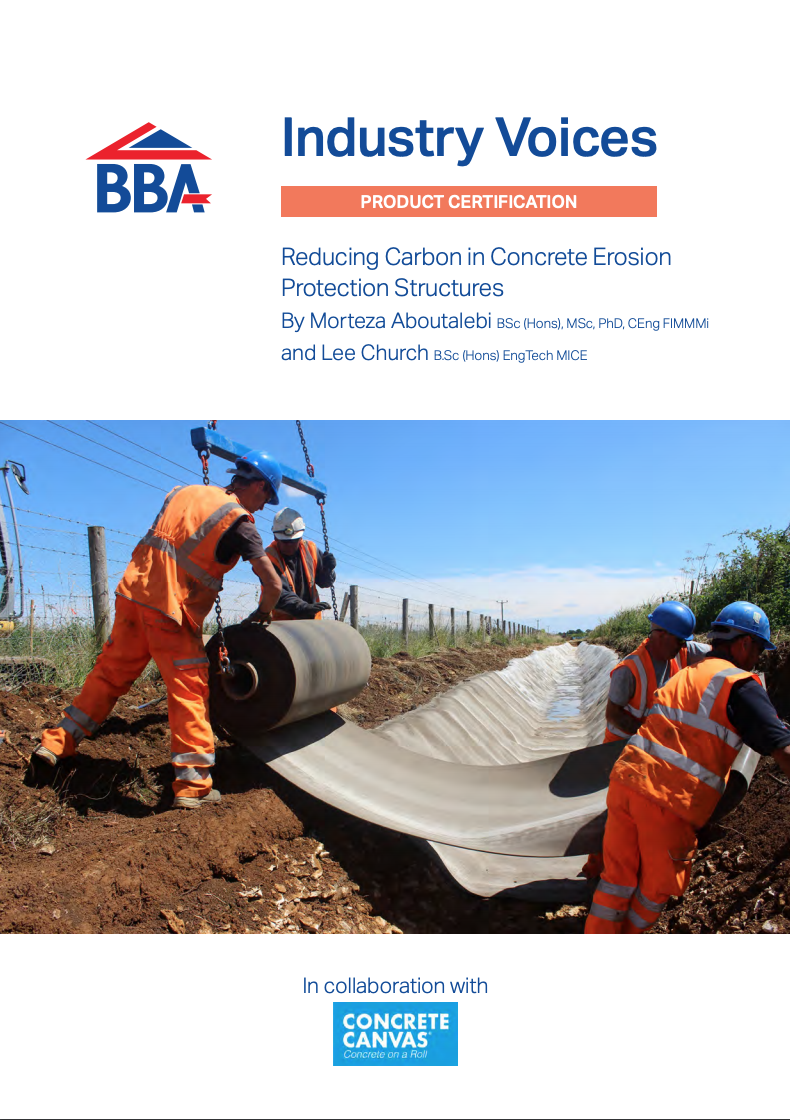If we want standards to drive innovation and decarbonisation, are we asking the right questions?
In September, the BBA published Never Waste a Good Crisis, an article arguing that Net Zero might be just the spur we need to tackle the part that standards play in the construction industry’s conservatism and reluctance to embrace innovation. That piece ended with some suggestions for improving how BSI and other bodies work with the sector to deliver standards that are both timely and at the very least do not act as a drag on bringing low carbon products into general use.
Those suggestions have spawned some interesting conversations with industry players, not least about how we might shift how we think about the role of standards – and the need for stakeholders across the industry to shoulder their share of responsibility for driving change.
The decarbonisation division of labour!
The September article focused in on how to decarbonise cement and concrete, two of the biggest sources of embedded emissions in the built environment. In a recent blog post, Will Arnold, Head of Climate Action at the Institution of Structural Engineers, sets out a simple way of thinking about this issue:
Embodied carbon = (quantity of materials) x (carbon intensity factor)
A division of labour then follows, in which the first half of the equation sets an agenda for those working to finance, commission, design, construct and maintain buildings – fundamentally they need to push hard to use less stuff. This isn’t simply about producing leaner designs, it means going right back up into concept stage and prioritising better (re)use of existing structures and only then designing any new buildings to minimise material use.
Materials producers, manufacturers and research labs then face a parallel challenge to develop new products – it’s clear that we can’t get to Net Zero with current materials – but equally we can’t stop building altogether.
We might even want to break this second challenge down into a further two buckets:
- Getting materials that exist (and are being used in exemplar projects) into wider use straight away
- Accelerating the progress of promising new materials like Cambridge University’s zero emissions cement from the lab into exemplars and on into wider use
Investing time and money into standards
Both of these sub-challenges require industry investment of time and money to develop the materials and get them into standards. In an ideal world, the UK might take a war economy approach to bringing through the materials we need to deal with an existential risk like climate change. Or we could at least learn the lessons from the COVID vaccine programme’s combination of Venture Capitalist techniques and fast track clinical trials – after all it’s a common complaint that some standards take as long to create as it takes a new life saving medicine to secure approval. The Prime Minister’s recent rowing back on some climate commitments are however another demonstration that the slow, long-term nature of the climate crisis simply doesn’t generate the political will for these kinds of measures.
So, government isn’t going to come riding over the hill to save us. Similarly, while BSI can clearly take steps to evolve its ways of working (of which more below), it would also benefit from a more proactive approach from an industry, that is prioritising change.
An industry figure who has recently been involved with updating a standard to facilitate the rollout of a new lower carbon cement told me that if there is the will, and stakeholders are well resourced and persistent, in some cases it should be possible to move from submitting a proposal to BSI, to launching a new standard in 2-3 years. Product developers do however have to be willing to commit time to engaging directly with BSI and the relevant Technical Committee to explain the case for change. They are also likely to need to commit time to the technical work needed to create detailed draft standards – and of course generate evidence to support these changes.
They added that there are opportunities for BSI to improve how it works with industry, for example by being clearer on the processes used for producing or revising a standard (it is surprisingly difficult to find a simple flowchart). Likewise, individual Technical Committees need to communicate more effectively. Committee Chairs could publish their work programmes as part of a general push to increase transparency and accountability. They could also be much clearer about their stance on crucial issues such as what testing programmes or other evidence they will need to see to support changes.
Flipping the question
Another industry figure suggested we need to step back and address the question of what is a standard and how do want to use it. Their answer was that it’s a benchmark or a codification of collective knowledge and wisdom that we use to build the confidence of the users of a product and other important stakeholders such as their insurers. In this context, many standards also serve as an audit tool to help demonstrate that we are doing the right thing in a defined set of circumstance – often in conjunction with other tools, for example BREEAM assessments or BBA’s Agrément Certification.
If you asked many construction professionals the same philosophical question, many would probably give a similar answer. But would they give you the same answer if asked how they are used in practice? I suspect that in many cases, standards are viewed as less a flexible tool to build confidence and more something to be complied with – and worse something being done to us by a process we don’t understand or control.
As a result, conservatism, never far from the surface in the construction industry, can easily kick in.
So perhaps to make progress we need to change the question from what do standards bodies have to do to remove barriers to innovation to how can we as an industry better build confidence in innovations in key areas like Net Zero sufficiently rapidly so that standards can be an effective tool in their roll out.
Do you agree? We’d be delighted to hear your views.
Share This Story, Choose Your Platform!
Related News
If we want standards to drive innovation and decarbonisation, are we asking the right questions?
In September, the BBA published Never Waste a Good Crisis, an article arguing that Net Zero might be just the spur we need to tackle the part that standards play in the construction industry’s conservatism and reluctance to embrace innovation. That piece ended with some suggestions for improving how BSI and other bodies work with the sector to deliver standards that are both timely and at the very least do not act as a drag on bringing low carbon products into general use.
Those suggestions have spawned some interesting conversations with industry players, not least about how we might shift how we think about the role of standards – and the need for stakeholders across the industry to shoulder their share of responsibility for driving change.
The decarbonisation division of labour!
The September article focused in on how to decarbonise cement and concrete, two of the biggest sources of embedded emissions in the built environment. In a recent blog post, Will Arnold, Head of Climate Action at the Institution of Structural Engineers, sets out a simple way of thinking about this issue:
Embodied carbon = (quantity of materials) x (carbon intensity factor)
A division of labour then follows, in which the first half of the equation sets an agenda for those working to finance, commission, design, construct and maintain buildings – fundamentally they need to push hard to use less stuff. This isn’t simply about producing leaner designs, it means going right back up into concept stage and prioritising better (re)use of existing structures and only then designing any new buildings to minimise material use.
Materials producers, manufacturers and research labs then face a parallel challenge to develop new products – it’s clear that we can’t get to Net Zero with current materials – but equally we can’t stop building altogether.
We might even want to break this second challenge down into a further two buckets:
- Getting materials that exist (and are being used in exemplar projects) into wider use straight away
- Accelerating the progress of promising new materials like Cambridge University’s zero emissions cement from the lab into exemplars and on into wider use
Investing time and money into standards
Both of these sub-challenges require industry investment of time and money to develop the materials and get them into standards. In an ideal world, the UK might take a war economy approach to bringing through the materials we need to deal with an existential risk like climate change. Or we could at least learn the lessons from the COVID vaccine programme’s combination of Venture Capitalist techniques and fast track clinical trials – after all it’s a common complaint that some standards take as long to create as it takes a new life saving medicine to secure approval. The Prime Minister’s recent rowing back on some climate commitments are however another demonstration that the slow, long-term nature of the climate crisis simply doesn’t generate the political will for these kinds of measures.
So, government isn’t going to come riding over the hill to save us. Similarly, while BSI can clearly take steps to evolve its ways of working (of which more below), it would also benefit from a more proactive approach from an industry, that is prioritising change.
An industry figure who has recently been involved with updating a standard to facilitate the rollout of a new lower carbon cement told me that if there is the will, and stakeholders are well resourced and persistent, in some cases it should be possible to move from submitting a proposal to BSI, to launching a new standard in 2-3 years. Product developers do however have to be willing to commit time to engaging directly with BSI and the relevant Technical Committee to explain the case for change. They are also likely to need to commit time to the technical work needed to create detailed draft standards – and of course generate evidence to support these changes.
They added that there are opportunities for BSI to improve how it works with industry, for example by being clearer on the processes used for producing or revising a standard (it is surprisingly difficult to find a simple flowchart). Likewise, individual Technical Committees need to communicate more effectively. Committee Chairs could publish their work programmes as part of a general push to increase transparency and accountability. They could also be much clearer about their stance on crucial issues such as what testing programmes or other evidence they will need to see to support changes.
Flipping the question
Another industry figure suggested we need to step back and address the question of what is a standard and how do want to use it. Their answer was that it’s a benchmark or a codification of collective knowledge and wisdom that we use to build the confidence of the users of a product and other important stakeholders such as their insurers. In this context, many standards also serve as an audit tool to help demonstrate that we are doing the right thing in a defined set of circumstance – often in conjunction with other tools, for example BREEAM assessments or BBA’s Agrément Certification.
If you asked many construction professionals the same philosophical question, many would probably give a similar answer. But would they give you the same answer if asked how they are used in practice? I suspect that in many cases, standards are viewed as less a flexible tool to build confidence and more something to be complied with – and worse something being done to us by a process we don’t understand or control.
As a result, conservatism, never far from the surface in the construction industry, can easily kick in.
So perhaps to make progress we need to change the question from what do standards bodies have to do to remove barriers to innovation to how can we as an industry better build confidence in innovations in key areas like Net Zero sufficiently rapidly so that standards can be an effective tool in their roll out.
Do you agree? We’d be delighted to hear your views.
Share This Story, Choose Your Platform!
Related News
Get in touch
Please complete the form below and we will contact you as soon as possible.
To help us to respond to your inquiry as quickly as possible, we have put a handy list of our services below.


